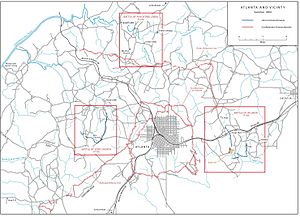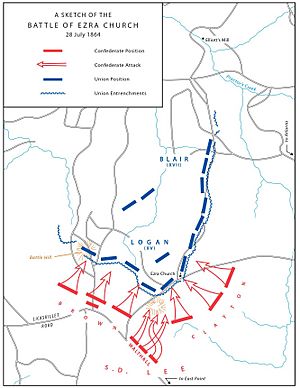Battle of Ezra Church facts for kids
Quick facts for kids Battle of Ezra Church(Battle of Ezra Chapel) |
|||||||
|---|---|---|---|---|---|---|---|
| Part of the American Civil War | |||||||
 Engraving of the battle by Theodore R. Davis for Harper's Weekly |
|||||||
|
|||||||
| Belligerents | |||||||
| Commanders and leaders | |||||||
| William T. Sherman Oliver Otis Howard |
John B. Hood Stephen D. Lee A. P. Stewart |
||||||
| Units involved | |||||||
| Army of the Tennessee | Army of Tennessee | ||||||
| Strength | |||||||
| 13,266 | 18,450 | ||||||
| Casualties and losses | |||||||
| 642 | 3,000 | ||||||
The Battle of Ezra Church was an important fight during the American Civil War. It happened on July 28, 1864, in Fulton County, Georgia. This battle is also known as the Battle of Ezra Chapel or the Battle of the Poor House. It was part of the larger Atlanta campaign.
In this battle, Union Army forces were led by Major General William Tecumseh Sherman. They fought against Confederate States Army troops, who were led by Lieutenant General John Bell Hood. General Sherman wanted to cut off the railroad lines that supplied the city of Atlanta. This would force the Confederates to leave the city.
Sherman sent a part of his army, led by Major General Oliver Otis Howard, to go around the west side of Atlanta. Their goal was to cut the Macon and Western Railroad. General Hood knew what Sherman was trying to do. He sent two groups of Confederate soldiers to stop them. These groups were led by Generals Stephen D. Lee and Alexander P. Stewart.
The Confederates attacked Howard's troops before they could reach the railroad. The Union soldiers were ready and fought back hard. The Confederates suffered many losses. Even though the Confederates lost the battle, they did stop the Union army from cutting the railroad that day.
From May to July 1864, Sherman's Union forces, which had more soldiers, pushed the Confederates back. They reached the edge of Atlanta. The Confederate President, Jefferson Davis, was not happy with his general, Joseph E. Johnston. So, he replaced him with General Hood. Hood immediately launched two big attacks on Sherman's armies. These were the Battle of Peachtree Creek on July 20 and the Battle of Atlanta on July 22. Both attacks failed, and many soldiers were lost on both sides.
After the Battle of Ezra Church, Sherman kept trying to cut the railroads leading into Atlanta. Hood's army managed to stop these efforts for about a month. But finally, the last railroad line was cut on August 31 during the Battle of Jonesborough.
What Led to the Battle of Ezra Church?
The Battle of Ezra Church was one of many battles in the Atlanta campaign. The main goal of this campaign was to weaken the city of Atlanta. Atlanta was a very important place for the South during the war. It was a center for making supplies, getting goods, and treating wounded soldiers.
Before Ezra Church, the Battle of Peachtree Creek had just happened. After that battle, General Hood had to pull his soldiers back to the final defenses around Atlanta by July 21, 1864. Sherman thought that Hood was leaving the city. So, he sent another general, McPherson, to the southeast towards Decatur.
Hood then sent a group of soldiers to meet McPherson and attack on July 22. Sadly, General McPherson was killed in that battle. After his death, General Oliver Otis Howard took command of the Union Army of the Tennessee. Sherman's next move was to go back west. This is when the Battle of Ezra Church happened on July 28.
This battle was part of Sherman's bigger plan to cut and destroy all the railroad lines. By July 24, the Macon & Western line was the only one left that led into Atlanta. Sherman needed to cut this last line to truly trap the city.
The Battle of Ezra Church: A Closer Look
Sherman's army was spread out in a wide curve around the northern defenses of Atlanta. Sherman's plan was to cut off the railroad supply lines that brought supplies from Macon, Georgia, into Atlanta. This would force the Confederate army defending Atlanta to leave without a direct attack.
To do this, Sherman ordered his easternmost army, led by Major General Oliver Otis Howard, to move north and then west. They went around the rest of the Union lines to the far western side of Atlanta. This was where the railroad entered the city.
General Hood guessed what Sherman was planning. He moved his troops out to stop the Union army. Hood wanted to surprise them. Even though Hood's Confederate troops had fewer soldiers than the main Union army, he thought a surprise attack on a smaller, separated part of the enemy could work.
The two armies met on the afternoon of July 28 at a small church called Ezra Church. But Hood's plan for a surprise attack didn't work. General Howard was not surprised at all! He had already reached the road near Ezra Church and had his soldiers dig in by 11 a.m. that day. Howard had predicted Hood's move because he knew Hood from their time together at West Point before the war.
Howard's troops were already waiting in their trenches when Hood's soldiers arrived. The Confederate army also made some mistakes. They didn't scout the area enough, they thought there were fewer Union soldiers than there actually were, and their attack was not well-coordinated. They had to fall back when they faced the Union army's makeshift defenses, which were made of logs and rails.
The Confederates were defeated in the battle. However, they did manage to stop Howard from reaching the railroad line that day. In total, about 3,642 soldiers were killed or wounded. About 3,000 of these were Confederates, and 642 were Union soldiers. Among the wounded was General Alexander P. Stewart, who led a group of soldiers under Hood.
Another brave soldier in this battle was Ernst R. Torgler. He was a 24-year-old sergeant in the 37th Ohio Infantry. He later received the Medal of Honor for his actions during the battle. Torgler saved the life of his commanding officer, Major Charles Hipp. His award citation says that "At great hazard of his life he saved his commanding officer, then badly wounded, from capture."
Images for kids






